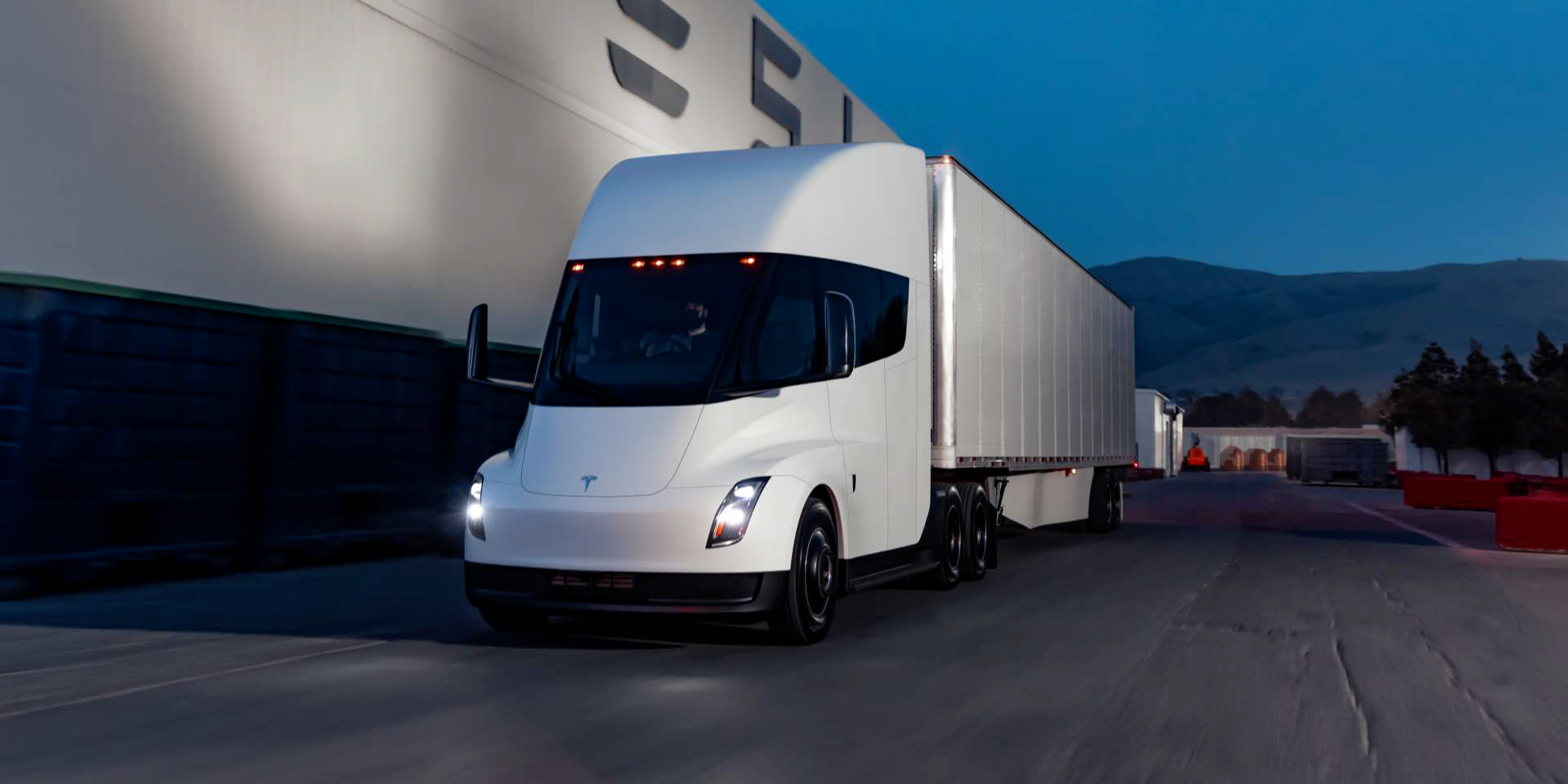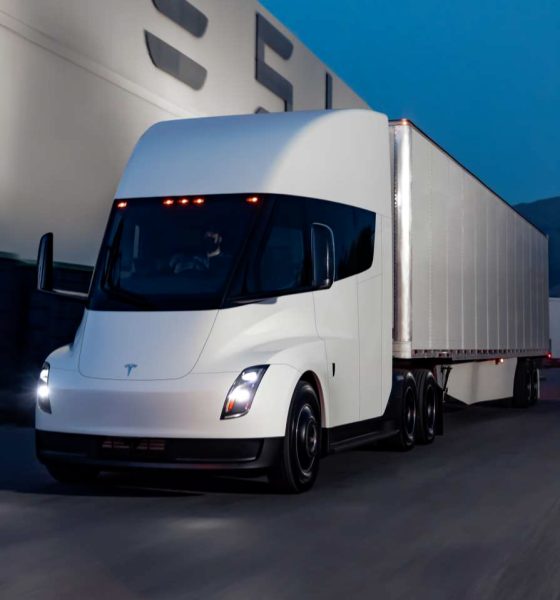

News
Electric trucks like the Tesla Semi are nearing cost parity with diesel, EU studies show
Two new studies from the Stockholm Environment Institute (SEI) and Transport & Environment (T&E) have suggested that advances in technology would enable battery-powered heavy trucks like the Tesla Semi to become cheaper to own and run compared to their petrol and diesel counterparts. According to T&E, these studies are even more proof that the future of the heavy trucking industry is electric.
T&E’s study focused on Germany’s long-haul trucking segment, and according to the agency, direct electrification of road freight is not only technically feasible: it is likely to reach cost parity with diesel by the middle of the decade. The agency also noted that directly electrifying trucks are around twice as energy efficient as renewable hydrogen and about three times as efficient as internal combustion engines running on synthetic e-fuels.
SEI’s report, on the other hand, noted that the electrification of the heavy trucking sector becomes very realistic if the massive battery-powered vehicles could be rapidly charged like all-electric passenger cars. With a rapid-charging infrastructure in place, the required range for battery-powered long-haulers gets dramatically reduced. This means that even vehicles like the Volvo VNR Electric Class 8 truck, which only has an operating range of 150 miles, could be utilized to their utmost potential.
This, together with the advances in battery technology, could ultimately enable the all-electric long-haul segment to thrive. Björn Nykvist, the lead author and senior researcher at SEI, related this in a statement. “Battery technology is very close to a threshold that makes electric trucks feasible and economically competitive,” the researcher said.
Tiziana Frongia, freight director at T&E, further noted that the time is now to push electric trucks into the market, as even existing vehicles available today could already cover most urban and regional deliveries. Longer routes, on the other hand, could be handled by upcoming trucks such as the Tesla Semi, which is expected to have a range of over 500 miles per charge. For Frongia, the future of trucking is electric, and it’s now up to the EU to ensure that the shift to sustainable trucking is expedited.
“The future of trucking is electric. Most urban and regional deliveries can already be covered by electric trucks today, and long-haul electric trucks are only a few years behind. The environmental case is clear and now so is the cost argument. The EU should therefore speed up the transition towards electrification by setting binding targets for truck charging stations in the upcoming review of the infrastructure law… The evidence is stacking up. If electric trucking seemed like a pipe dream just a few years ago, it definitely isn’t anymore. We’ve shown that it is possible. Will the EU make it a reality?” the T&E freight director said.
While there is an inherent challenge in rolling out all-electric long-haulers due to the large number of batteries they require, companies like Tesla are hard at work in ensuring that their trucks are competitive against more conventional rivals. Tesla, for its part, has noted that the Semi, which has been delayed for a few years now, is finally poised to begin deliveries later this year. Elon Musk has also stated that limitations in battery supply would likely be less onerous next year, which suggests that the Tesla Semi’s production could hit its pace in 2022.
Check out Transport & Environment’s study below.
2021 04 TE How to Decarbonise Long Haul Trucking in Germany Final by Simon Alvarez on Scribd
Don’t hesitate to contact us for news tips. Just send a message to tips@teslarati.com to give us a heads up.

Elon Musk
Starlink passes 9 million active customers just weeks after hitting 8 million
The milestone highlights the accelerating growth of Starlink, which has now been adding over 20,000 new users per day.

SpaceX’s Starlink satellite internet service has continued its rapid global expansion, surpassing 9 million active customers just weeks after crossing the 8 million mark.
The milestone highlights the accelerating growth of Starlink, which has now been adding over 20,000 new users per day.
9 million customers
In a post on X, SpaceX stated that Starlink now serves over 9 million active users across 155 countries, territories, and markets. The company reached 8 million customers in early November, meaning it added roughly 1 million subscribers in under seven weeks, or about 21,275 new users on average per day.
“Starlink is connecting more than 9M active customers with high-speed internet across 155 countries, territories, and many other markets,” Starlink wrote in a post on its official X account. SpaceX President Gwynne Shotwell also celebrated the milestone on X. “A huge thank you to all of our customers and congrats to the Starlink team for such an incredible product,” she wrote.
That growth rate reflects both rising demand for broadband in underserved regions and Starlink’s expanding satellite constellation, which now includes more than 9,000 low-Earth-orbit satellites designed to deliver high-speed, low-latency internet worldwide.
Starlink’s momentum
Starlink’s momentum has been building up. SpaceX reported 4.6 million Starlink customers in December 2024, followed by 7 million by August 2025, and 8 million customers in November. Independent data also suggests Starlink usage is rising sharply, with Cloudflare reporting that global web traffic from Starlink users more than doubled in 2025, as noted in an Insider report.
Starlink’s momentum is increasingly tied to SpaceX’s broader financial outlook. Elon Musk has said the satellite network is “by far” the company’s largest revenue driver, and reports suggest SpaceX may be positioning itself for an initial public offering as soon as next year, with valuations estimated as high as $1.5 trillion. Musk has also suggested in the past that Starlink could have its own IPO in the future.
News
NVIDIA Director of Robotics: Tesla FSD v14 is the first AI to pass the “Physical Turing Test”
After testing FSD v14, Fan stated that his experience with FSD felt magical at first, but it soon started to feel like a routine.

NVIDIA Director of Robotics Jim Fan has praised Tesla’s Full Self-Driving (Supervised) v14 as the first AI to pass what he described as a “Physical Turing Test.”
After testing FSD v14, Fan stated that his experience with FSD felt magical at first, but it soon started to feel like a routine. And just like smartphones today, removing it now would “actively hurt.”
Jim Fan’s hands-on FSD v14 impressions
Fan, a leading researcher in embodied AI who is currently solving Physical AI at NVIDIA and spearheading the company’s Project GR00T initiative, noted that he actually was late to the Tesla game. He was, however, one of the first to try out FSD v14.
“I was very late to own a Tesla but among the earliest to try out FSD v14. It’s perhaps the first time I experience an AI that passes the Physical Turing Test: after a long day at work, you press a button, lay back, and couldn’t tell if a neural net or a human drove you home,” Fan wrote in a post on X.
Fan added: “Despite knowing exactly how robot learning works, I still find it magical watching the steering wheel turn by itself. First it feels surreal, next it becomes routine. Then, like the smartphone, taking it away actively hurts. This is how humanity gets rewired and glued to god-like technologies.”
The Physical Turing Test
The original Turing Test was conceived by Alan Turing in 1950, and it was aimed at determining if a machine could exhibit behavior that is equivalent to or indistinguishable from a human. By focusing on text-based conversations, the original Turing Test set a high bar for natural language processing and machine learning.
This test has been passed by today’s large language models. However, the capability to converse in a humanlike manner is a completely different challenge from performing real-world problem-solving or physical interactions. Thus, Fan introduced the Physical Turing Test, which challenges AI systems to demonstrate intelligence through physical actions.
Based on Fan’s comments, Tesla has demonstrated these intelligent physical actions with FSD v14. Elon Musk agreed with the NVIDIA executive, stating in a post on X that with FSD v14, “you can sense the sentience maturing.” Musk also praised Tesla AI, calling it the best “real-world AI” today.
News
Tesla AI team burns the Christmas midnight oil by releasing FSD v14.2.2.1
The update was released just a day after FSD v14.2.2 started rolling out to customers.

Tesla is burning the midnight oil this Christmas, with the Tesla AI team quietly rolling out Full Self-Driving (Supervised) v14.2.2.1 just a day after FSD v14.2.2 started rolling out to customers.
Tesla owner shares insights on FSD v14.2.2.1
Longtime Tesla owner and FSD tester @BLKMDL3 shared some insights following several drives with FSD v14.2.2.1 in rainy Los Angeles conditions with standing water and faded lane lines. He reported zero steering hesitation or stutter, confident lane changes, and maneuvers executed with precision that evoked the performance of Tesla’s driverless Robotaxis in Austin.
Parking performance impressed, with most spots nailed perfectly, including tight, sharp turns, in single attempts without shaky steering. One minor offset happened only due to another vehicle that was parked over the line, which FSD accommodated by a few extra inches. In rain that typically erases road markings, FSD visualized lanes and turn lines better than humans, positioning itself flawlessly when entering new streets as well.
“Took it up a dark, wet, and twisty canyon road up and down the hill tonight and it went very well as to be expected. Stayed centered in the lane, kept speed well and gives a confidence inspiring steering feel where it handles these curvy roads better than the majority of human drivers,” the Tesla owner wrote in a post on X.
Tesla’s FSD v14.2.2 update
Just a day before FSD v14.2.2.1’s release, Tesla rolled out FSD v14.2.2, which was focused on smoother real-world performance, better obstacle awareness, and precise end-of-trip routing. According to the update’s release notes, FSD v14.2.2 upgrades the vision encoder neural network with higher resolution features, enhancing detection of emergency vehicles, road obstacles, and human gestures.
New Arrival Options also allowed users to select preferred drop-off styles, such as Parking Lot, Street, Driveway, Parking Garage, or Curbside, with the navigation pin automatically adjusting to the ideal spot. Other refinements include pulling over for emergency vehicles, real-time vision-based detours for blocked roads, improved gate and debris handling, and Speed Profiles for customized driving styles.








